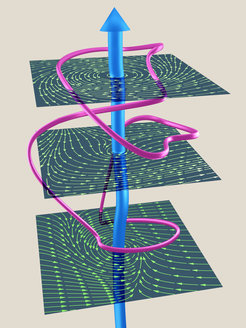A link between entropy production and topology
The Department Living Matter Physics from the Max Planck Institute for Dynamics and Self-Organization (MPI-DS) revealed a link between the generation of entropy and the topological features of a system. In their study, recently published in Nature Communications, the scientists investigated the random motion of particles in vortex flows. They found that fluctuations in entropy production can be characterized based only on the number of windings around the vortex, but not on the shape or size of the trajectory. These findings could contribute to a better understanding of microscopic systems, such as micro-motors or particles moving in biological media.
One of the fundamental tenets of physics is the second law of thermodynamics, which states that the amount of disorder in a system, called entropy, always increases over time. In practical terms, this can be illustrated by a droplet of ink added to a glass of water: it will spread throughout the glass by itself increasing the overall entropy. A reformation of the ink droplet – and thus an increase of the order and decrease of the entropy in the system – does not happen in practical terms.
Entropy fluctuations occur on a microscale level

However, when describing such a system mathematically, there remains an extremely small probability that the order will eventually revert into the system due to spontaneous fluctuations. Whereas this is hardly ever observed in macroscopic systems, on a microscopic scale such fluctuations can play an important role in the overall behavior of a system. In their recent study, the scientists in the department of Living Matter Physics investigated closed trajectories around a vortex. “When a particle is released into the flow of a vortex, it naturally follows the circular current” explains Benoît Mahault, first author of the study and group leader at MPI-DS. “However, due to the intrinsic fluctuations in the medium, there also exists a small probability that the particle moves against the flow. Overall, the two opposing movements will result in a net motion along the current, but statistically both components of the motion can be observed” he continues. Naturally, in strong flows the movement against the current plays only a minor role. Hence, this model is especially relevant for very low currents on a microscopic scale where the effect of noise is important – such as molecular motors or transport mechanisms.
Linking fluctuations in entropy production and topology
Observing a particle that follows a vortex in a closed loop, the researchers made an interesting discovery: they found that the change in entropy associated with its trajectory is independent of the size and shape of the latter. In other words: a particle travelling in a large or deformed circle around the vortex creates the same amount of entropy or heat as the one in a small confined circle. The number of turns around the vortex hence is the only factor that determines the fluctuations. In mathematics, this phenomenon is called topological protection. It is known that topology plays an important role in biology as well as in quantum mechanics, butso far it has never been linked to strongly fluctuating systems. Essentially, if two shapes can be transformed into another without introducing novel breaks or links, they share the same topology. For instance, the letter o has the same topology as the letters D and O, but I, C and U would have a different topology. “The link between the macroscopic topological property and fluctuations in the entropy production that leads to a quantization of heat is the key finding of our study” highlights Ramin Golestanian, principal investigator of the study and managing director of the MPI-DS. “Revealing this fundamental connection can provide valuable insights in the understanding of the mysteries of non-equilibrium physics at the small scale”, he concludes.
